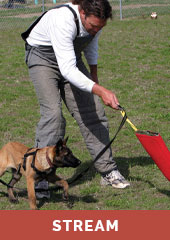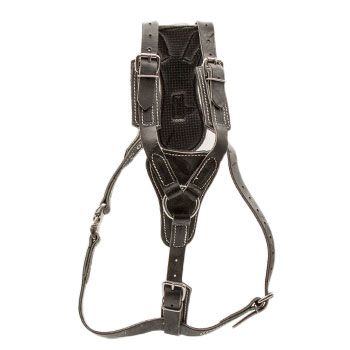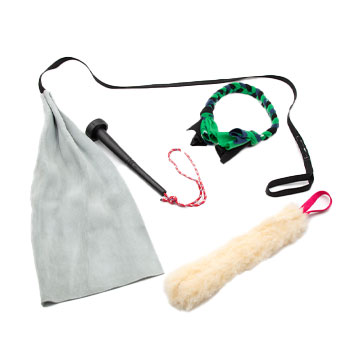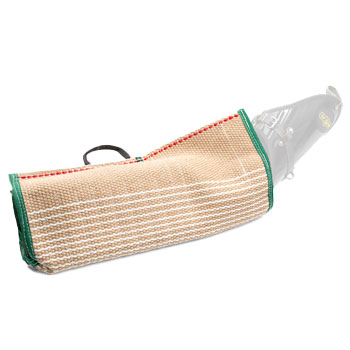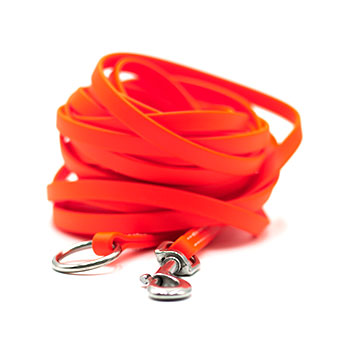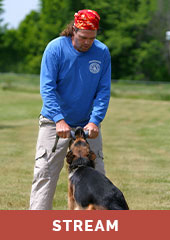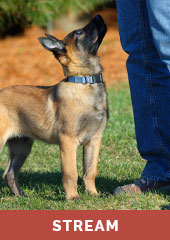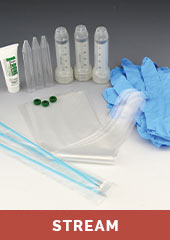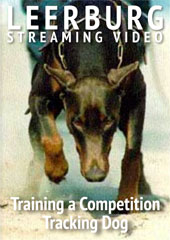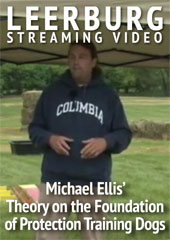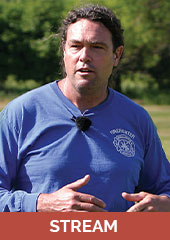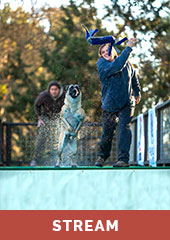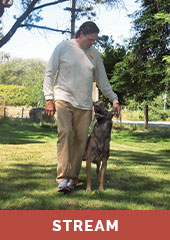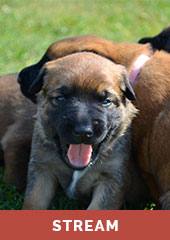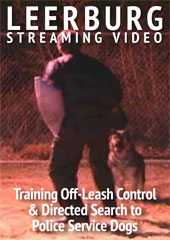4 hr, 3 min
June 28, 2011
I went to my first protection training seminar in summer of 1974 and can honestly say that the training in this DVD is the most in depth study on the foundation of bite training for puppies that has ever been done.
The video footage for this production has come from work with Michael Ellis that has been filmed over a 4 year period. We have dogs in this video that were filmed as 10 week old puppies that are 4 years old today.
If you have studied the 7 earlier DVDs I have done with Michael Ellis, you will understand why I can honestly say that Michael is a genius at dog training. He takes training to a different level than anyone I have ever known.
Michael divides the life of a working dog into five different categories:
1. Pre-Teething
2. Teething
3. Adolescent
4. Young Adult
5. Adult
In this 4 hour DVD, we will cover the foundation of bite work for the first three categories. We will cover, in step by step detail, the foundation of bite work with 8 week old puppies up through teaching adolescent dogs to bite arms and legs on leg sleeves.
The video opens with a lecture from Michael explaining his theory of the foundation of protection training puppies. He discusses the various temperaments of dogs and he talks about what dogs should and should not be trained.
Michael does not believe in training dogs that are not genetically capable of doing the work. In fact, one of the chapters of the video shows dogs that should never be protection trained.
Michael believes that we are doing a great injustice to a dog by forcing it into protection training when it doesn't want to do the work. As Michael explains, "the people who do this only produce dogs that are nervous dogs that are dangerous to be around."
Michael goes on to explain what type of temperaments various puppies have that benefit from pre-teething training and which puppies are better off having their work done after teething.
The goal of adolescent training is to teach a dog:
1. Targeting behavior
2. Get the dog used to biting different equipment
3. Get the dog used to Environmental Stressors
4. Introduce the dog to Personal Stressors
5. Introduce the dog to Physical Stressors
Michael teaches his students how to recognize and establish a genetic baseline for their dogs. To effectively train a dog in bite work, the trainers must know exactly what their dogs' genetic likes and dislikes are in biting.
Some dogs genetically push in while biting. Some dogs genetically pull back while biting, some growl, some shake, some chomp down and don't move their grip.
Trainers and decoys must recognize these baselines if they are ever going to establish a bite training program that is tailored for their dogs.
During this opening lecture, Michael talks about dogs' genetic thresholds for the work. He discusses low and high thresholds both for prey and defense. He talks about the difference between a threshold and a response to an aggressor. These are two different things and that many confuse and think of as a single event.
Michael trains dogs with harnesses but does not introduce a young puppy to the harness and leash until its conditioned to wearing both in protection work. This video shows exactly when puppies should be worked on a line and in a harness.
There are a number of things that handlers should do themselves to prepare their puppies for protection training. We have a chapter in the DVD on the foundation work that handlers should do before their puppy is introduced to a decoy.
We also have a chapter on the "Role of the Handler during Protection Work." The fact is, it is the handler's responsibility (not the decoy) to keep and maintain the flow of training. It is the handler's responsibility to keep his dog facing the decoy, to not put equipment on the ground and thrash it and to maintain focus for the work. These are things are covered in the DVD.
Handlers also need to understand what to do after the decoy slips a piece of equipment. Many sport trainers have been taught to simply kick the equipment away from their dog after the dog OUTs. The fact is, for a lot of dogs, this is exactly the wrong thing to do.
Handlers need to learn how to let their dogs drag them to the decoy. They need to know what speed to allow the dog to drag them in at. They need to know when and why to speed up and when and why to slow it down.
Handlers need to learn when to come up the line to collect their dog and when to give leash pressure to set a grip. Just as importantly, they need to learn when and why to give a loose leash so the dog can re-grip (called a COUNTER) into the bite. These points are all covered in detail in the DVD.
We have a chapter in the DVD in which Michael explains "Teaching Your Puppy Man Orientation." Man orientation is NOT DEFENSE. Man orientation is an exercise in which the puppy is trained to keep his focus on the decoy and not the equipment. Old school trainers did this by putting a dog in defense. That's not how Michael Ellis teaches this skill to very young puppies.
During protection work, the decoy will introduce a puppy to what we call "opposition reflex to the decoys hands." This is a learned exercise and one that starts with very young dogs and continues on into young adulthood. By teaching this skill correctly, the young dog will learn to automatically bite harder when exposed to a serious decoy who attempts to man handle the dog.
One of the goals of early training is to teach the young dogs to bite and look for the decoy in the equipment. We don't just want a dog to blindly bite and hold equipment. We want them to bite in and feel for the decoy inside the equipment. We teach the young dog that in doing this they can control and drive the training session.
Early in the video, Michael explains the process of bringing a young puppy up through the various equipment used in training. He explains how he starts using tugs, bite pillows and soft arms. Our video explains how soft arms are used to transition a dog onto a leg sleeve.
Trainers will learn how to teach a dog correct and safe leg biting techniques. Dogs must learn to bite with their eyes to the outside of the decoys legs. That is the safest way for a dog to bite a leg and not get injured. When dogs bite with their eyes to the inside of the leg their neck is turned and they run the risk of injury if the decoy kicks out. Correct biting style is a learned skill that we cover in a great deal of detail.
While this is a dog training DVD, the fact is it is also a young dog decoy training DVD. The work we are showing will not only help handlers train their dogs, it should be used by decoys to learn how to properly train young puppies and adolescent dogs.
We included a chapter on teaching decoys the correct form in how to take leg bites on leg sleeves. The decoys will learn proper presentation and how to safely place a dog on the front lower part of the leg.
We have a chapter in what trainers need to do to eliminate "equipment bias." Equipment bias occurs when a dog will only bite certain training equipment. It's not uncommon to see dogs that have come up in other training styles only want to bite soft arms and won't bite hard arms, or dogs that will only bite jute equipment and won't bite linen.
The fact is there are a lot of police service dogs that are working the street that have equipment bias. These dogs will bite a man in a suit like an alligator but won't bite a real criminal without any training equipment.
We close the DVD with a chapter by showing how to help dogs that have experienced a bad foundation in other systems of training. Unfortunately, there are a lot of these dogs out there. When the work in this DVD gets into training clubs and the hands of serious dog trainers, there will be a lot fewer dogs with problems in this work.
We want to emphasize that new trainers should watch and study the work in this production many many times - like 20 or 30. We understand that this is a lot of hours, but with that said there is a lot to learn to do this training correctly.
You will find that the more times you watch the DVD the more new things you will learn that you had missed in earlier viewings.
We feel that once trainers understand the training program they will learn from every new dog they watch being brought up through this training system.
Video on Demand
Instant access for a lifetime
Get huge savings on the DVD (view details)
Stream from anywhere around the world
Easy to jump to chapters
Add bookmarks/notes while you watch
Need help? Check our FAQ.
The Foundation of Puppy Bite Work (8 Weeks up to 16 Months) with Michael Ellis
Uploaded on June 28, 2011 •
4 hr, 3 min
I went to my first protection training seminar in summer of 1974 and can honestly say that the training in this DVD is the most in depth study on the foundation of bite training for puppies that has ever been done.
The video footage for this production has come from work with Michael Ellis that has been filmed over a 4 year period. We have dogs in this video that were filmed as 10 week old puppies that are 4 years old today.
If you have studied the 7 earlier DVDs I have done with Michael Ellis, you will understand why I can honestly say that Michael is a genius at dog training. He takes training to a different level than anyone I have ever known.
Michael divides the life of a working dog into five different categories:
1. Pre-Teething
2. Teething
3. Adolescent
4. Young Adult
5. Adult
In this 4 hour DVD, we will cover the foundation of bite work for the first three categories. We will cover, in step by step detail, the foundation of bite work with 8 week old puppies up through teaching adolescent dogs to bite arms and legs on leg sleeves.
The video opens with a lecture from Michael explaining his theory of the foundation of protection training puppies. He discusses the various temperaments of dogs and he talks about what dogs should and should not be trained.
Michael does not believe in training dogs that are not genetically capable of doing the work. In fact, one of the chapters of the video shows dogs that should never be protection trained.
Michael believes that we are doing a great injustice to a dog by forcing it into protection training when it doesn't want to do the work. As Michael explains, "the people who do this only produce dogs that are nervous dogs that are dangerous to be around."
Michael goes on to explain what type of temperaments various puppies have that benefit from pre-teething training and which puppies are better off having their work done after teething.
The goal of adolescent training is to teach a dog:
1. Targeting behavior
2. Get the dog used to biting different equipment
3. Get the dog used to Environmental Stressors
4. Introduce the dog to Personal Stressors
5. Introduce the dog to Physical Stressors
Michael teaches his students how to recognize and establish a genetic baseline for their dogs. To effectively train a dog in bite work, the trainers must know exactly what their dogs' genetic likes and dislikes are in biting.
Some dogs genetically push in while biting. Some dogs genetically pull back while biting, some growl, some shake, some chomp down and don't move their grip.
Trainers and decoys must recognize these baselines if they are ever going to establish a bite training program that is tailored for their dogs.
During this opening lecture, Michael talks about dogs' genetic thresholds for the work. He discusses low and high thresholds both for prey and defense. He talks about the difference between a threshold and a response to an aggressor. These are two different things and that many confuse and think of as a single event.
Michael trains dogs with harnesses but does not introduce a young puppy to the harness and leash until its conditioned to wearing both in protection work. This video shows exactly when puppies should be worked on a line and in a harness.
There are a number of things that handlers should do themselves to prepare their puppies for protection training. We have a chapter in the DVD on the foundation work that handlers should do before their puppy is introduced to a decoy.
We also have a chapter on the "Role of the Handler during Protection Work." The fact is, it is the handler's responsibility (not the decoy) to keep and maintain the flow of training. It is the handler's responsibility to keep his dog facing the decoy, to not put equipment on the ground and thrash it and to maintain focus for the work. These are things are covered in the DVD.
Handlers also need to understand what to do after the decoy slips a piece of equipment. Many sport trainers have been taught to simply kick the equipment away from their dog after the dog OUTs. The fact is, for a lot of dogs, this is exactly the wrong thing to do.
Handlers need to learn how to let their dogs drag them to the decoy. They need to know what speed to allow the dog to drag them in at. They need to know when and why to speed up and when and why to slow it down.
Handlers need to learn when to come up the line to collect their dog and when to give leash pressure to set a grip. Just as importantly, they need to learn when and why to give a loose leash so the dog can re-grip (called a COUNTER) into the bite. These points are all covered in detail in the DVD.
We have a chapter in the DVD in which Michael explains "Teaching Your Puppy Man Orientation." Man orientation is NOT DEFENSE. Man orientation is an exercise in which the puppy is trained to keep his focus on the decoy and not the equipment. Old school trainers did this by putting a dog in defense. That's not how Michael Ellis teaches this skill to very young puppies.
During protection work, the decoy will introduce a puppy to what we call "opposition reflex to the decoys hands." This is a learned exercise and one that starts with very young dogs and continues on into young adulthood. By teaching this skill correctly, the young dog will learn to automatically bite harder when exposed to a serious decoy who attempts to man handle the dog.
One of the goals of early training is to teach the young dogs to bite and look for the decoy in the equipment. We don't just want a dog to blindly bite and hold equipment. We want them to bite in and feel for the decoy inside the equipment. We teach the young dog that in doing this they can control and drive the training session.
Early in the video, Michael explains the process of bringing a young puppy up through the various equipment used in training. He explains how he starts using tugs, bite pillows and soft arms. Our video explains how soft arms are used to transition a dog onto a leg sleeve.
Trainers will learn how to teach a dog correct and safe leg biting techniques. Dogs must learn to bite with their eyes to the outside of the decoys legs. That is the safest way for a dog to bite a leg and not get injured. When dogs bite with their eyes to the inside of the leg their neck is turned and they run the risk of injury if the decoy kicks out. Correct biting style is a learned skill that we cover in a great deal of detail.
While this is a dog training DVD, the fact is it is also a young dog decoy training DVD. The work we are showing will not only help handlers train their dogs, it should be used by decoys to learn how to properly train young puppies and adolescent dogs.
We included a chapter on teaching decoys the correct form in how to take leg bites on leg sleeves. The decoys will learn proper presentation and how to safely place a dog on the front lower part of the leg.
We have a chapter in what trainers need to do to eliminate "equipment bias." Equipment bias occurs when a dog will only bite certain training equipment. It's not uncommon to see dogs that have come up in other training styles only want to bite soft arms and won't bite hard arms, or dogs that will only bite jute equipment and won't bite linen.
The fact is there are a lot of police service dogs that are working the street that have equipment bias. These dogs will bite a man in a suit like an alligator but won't bite a real criminal without any training equipment.
We close the DVD with a chapter by showing how to help dogs that have experienced a bad foundation in other systems of training. Unfortunately, there are a lot of these dogs out there. When the work in this DVD gets into training clubs and the hands of serious dog trainers, there will be a lot fewer dogs with problems in this work.
We want to emphasize that new trainers should watch and study the work in this production many many times - like 20 or 30. We understand that this is a lot of hours, but with that said there is a lot to learn to do this training correctly.
You will find that the more times you watch the DVD the more new things you will learn that you had missed in earlier viewings.
We feel that once trainers understand the training program they will learn from every new dog they watch being brought up through this training system.
The video footage for this production has come from work with Michael Ellis that has been filmed over a 4 year period. We have dogs in this video that were filmed as 10 week old puppies that are 4 years old today.
If you have studied the 7 earlier DVDs I have done with Michael Ellis, you will understand why I can honestly say that Michael is a genius at dog training. He takes training to a different level than anyone I have ever known.
Michael divides the life of a working dog into five different categories:
1. Pre-Teething
2. Teething
3. Adolescent
4. Young Adult
5. Adult
In this 4 hour DVD, we will cover the foundation of bite work for the first three categories. We will cover, in step by step detail, the foundation of bite work with 8 week old puppies up through teaching adolescent dogs to bite arms and legs on leg sleeves.
The video opens with a lecture from Michael explaining his theory of the foundation of protection training puppies. He discusses the various temperaments of dogs and he talks about what dogs should and should not be trained.
Michael does not believe in training dogs that are not genetically capable of doing the work. In fact, one of the chapters of the video shows dogs that should never be protection trained.
Michael believes that we are doing a great injustice to a dog by forcing it into protection training when it doesn't want to do the work. As Michael explains, "the people who do this only produce dogs that are nervous dogs that are dangerous to be around."
Michael goes on to explain what type of temperaments various puppies have that benefit from pre-teething training and which puppies are better off having their work done after teething.
The goal of adolescent training is to teach a dog:
1. Targeting behavior
2. Get the dog used to biting different equipment
3. Get the dog used to Environmental Stressors
4. Introduce the dog to Personal Stressors
5. Introduce the dog to Physical Stressors
Michael teaches his students how to recognize and establish a genetic baseline for their dogs. To effectively train a dog in bite work, the trainers must know exactly what their dogs' genetic likes and dislikes are in biting.
Some dogs genetically push in while biting. Some dogs genetically pull back while biting, some growl, some shake, some chomp down and don't move their grip.
Trainers and decoys must recognize these baselines if they are ever going to establish a bite training program that is tailored for their dogs.
During this opening lecture, Michael talks about dogs' genetic thresholds for the work. He discusses low and high thresholds both for prey and defense. He talks about the difference between a threshold and a response to an aggressor. These are two different things and that many confuse and think of as a single event.
Michael trains dogs with harnesses but does not introduce a young puppy to the harness and leash until its conditioned to wearing both in protection work. This video shows exactly when puppies should be worked on a line and in a harness.
There are a number of things that handlers should do themselves to prepare their puppies for protection training. We have a chapter in the DVD on the foundation work that handlers should do before their puppy is introduced to a decoy.
We also have a chapter on the "Role of the Handler during Protection Work." The fact is, it is the handler's responsibility (not the decoy) to keep and maintain the flow of training. It is the handler's responsibility to keep his dog facing the decoy, to not put equipment on the ground and thrash it and to maintain focus for the work. These are things are covered in the DVD.
Handlers also need to understand what to do after the decoy slips a piece of equipment. Many sport trainers have been taught to simply kick the equipment away from their dog after the dog OUTs. The fact is, for a lot of dogs, this is exactly the wrong thing to do.
Handlers need to learn how to let their dogs drag them to the decoy. They need to know what speed to allow the dog to drag them in at. They need to know when and why to speed up and when and why to slow it down.
Handlers need to learn when to come up the line to collect their dog and when to give leash pressure to set a grip. Just as importantly, they need to learn when and why to give a loose leash so the dog can re-grip (called a COUNTER) into the bite. These points are all covered in detail in the DVD.
We have a chapter in the DVD in which Michael explains "Teaching Your Puppy Man Orientation." Man orientation is NOT DEFENSE. Man orientation is an exercise in which the puppy is trained to keep his focus on the decoy and not the equipment. Old school trainers did this by putting a dog in defense. That's not how Michael Ellis teaches this skill to very young puppies.
During protection work, the decoy will introduce a puppy to what we call "opposition reflex to the decoys hands." This is a learned exercise and one that starts with very young dogs and continues on into young adulthood. By teaching this skill correctly, the young dog will learn to automatically bite harder when exposed to a serious decoy who attempts to man handle the dog.
One of the goals of early training is to teach the young dogs to bite and look for the decoy in the equipment. We don't just want a dog to blindly bite and hold equipment. We want them to bite in and feel for the decoy inside the equipment. We teach the young dog that in doing this they can control and drive the training session.
Early in the video, Michael explains the process of bringing a young puppy up through the various equipment used in training. He explains how he starts using tugs, bite pillows and soft arms. Our video explains how soft arms are used to transition a dog onto a leg sleeve.
Trainers will learn how to teach a dog correct and safe leg biting techniques. Dogs must learn to bite with their eyes to the outside of the decoys legs. That is the safest way for a dog to bite a leg and not get injured. When dogs bite with their eyes to the inside of the leg their neck is turned and they run the risk of injury if the decoy kicks out. Correct biting style is a learned skill that we cover in a great deal of detail.
While this is a dog training DVD, the fact is it is also a young dog decoy training DVD. The work we are showing will not only help handlers train their dogs, it should be used by decoys to learn how to properly train young puppies and adolescent dogs.
We included a chapter on teaching decoys the correct form in how to take leg bites on leg sleeves. The decoys will learn proper presentation and how to safely place a dog on the front lower part of the leg.
We have a chapter in what trainers need to do to eliminate "equipment bias." Equipment bias occurs when a dog will only bite certain training equipment. It's not uncommon to see dogs that have come up in other training styles only want to bite soft arms and won't bite hard arms, or dogs that will only bite jute equipment and won't bite linen.
The fact is there are a lot of police service dogs that are working the street that have equipment bias. These dogs will bite a man in a suit like an alligator but won't bite a real criminal without any training equipment.
We close the DVD with a chapter by showing how to help dogs that have experienced a bad foundation in other systems of training. Unfortunately, there are a lot of these dogs out there. When the work in this DVD gets into training clubs and the hands of serious dog trainers, there will be a lot fewer dogs with problems in this work.
We want to emphasize that new trainers should watch and study the work in this production many many times - like 20 or 30. We understand that this is a lot of hours, but with that said there is a lot to learn to do this training correctly.
You will find that the more times you watch the DVD the more new things you will learn that you had missed in earlier viewings.
We feel that once trainers understand the training program they will learn from every new dog they watch being brought up through this training system.
Comments
jmjenkins
July 2, 2022
Michael’s diamond pants are top notch.
lfroll
April 15, 2020
Tons of Great information. Thank you Leerburg and Michael for taking the time to put this together.
mor050515
December 27, 2018
Great Video. Love the quality, and the organization of the video. More Importantly I love Michael's ability to articulate and communicate that knowledge to the viewer.
Johnny1
May 10, 2016
Very well organized. Outstanding training instruction and I would HIGHLY encourage interested parties that would like to train their personal K-9s to proceed and order this great instructional resource. Mike Ellis is one of the best professionals to provide his personal training techniques that are easy to apply and determine the training that will accommodate your pups direction.
CarrasquilloC
September 5, 2015
Highly Reccomended DVD, Very good info for Experts and Upcoming handlers and decoys!!! Greetings from Puerto Rico!!
Aicha
May 6, 2015
ALLAH light your path Michael Ellis !!
Aicha
May 20, 2014
Very very very good DVD 1000 thank you I don't know what to say but thank you ALLAH
Jmoore771
December 12, 2013
Very nice video. I'm green when it comes to training, but it's something I think I could be great at once I put the work in and study your practices. I have a passion to learn the GSD psychology traits. What to look for etc. My male GSD pup just turned 12 weeks old. So far we have been easy on him... a little marking training. He has high food drive, prey drive is great for the most part... He loves biting. Whether it is my ankles, hands, fingers, arms, etc... he loves it and he has a very hard bite. He is getting better with the feet. I'm on my 7 days off and I was wanting to see if I could get a rough draft for my 7 days training. We play a few short tug sessions, try to mix it up. I'm thinking our Shih Tzu is a major distraction. Yap yap yap
With food in my hand. He is glued to me. Sits FAST, follows me... Sits fast. (Yes!)... reward...
One question... On several occasions when using a terry cloth, he will be going at it, shaking his head, and I let him win. He won, but then his attention turns to me (my hand or arm) once he drops the tug. I think he is going to be a great dog, as long as I don't mess him up. He is a very vocal dog. Not growl. I'll keep watching the 8 week to 16 months puppy bite work. Great videos
With food in my hand. He is glued to me. Sits FAST, follows me... Sits fast. (Yes!)... reward...
One question... On several occasions when using a terry cloth, he will be going at it, shaking his head, and I let him win. He won, but then his attention turns to me (my hand or arm) once he drops the tug. I think he is going to be a great dog, as long as I don't mess him up. He is a very vocal dog. Not growl. I'll keep watching the 8 week to 16 months puppy bite work. Great videos
GroupEspada
March 23, 2013
This is a really really good DVD. It is very detailed and much like being at a one-on-one Private training session with Michael Ellis. As a new trainer, I am very happy to have stumbled across this program and Michael's other classes, it really is a great product and provides a phenomenal foundation for anyone - new or experienced.
Hannadog
December 29, 2012
I have a 12 week old female Malinois that I wanted to begin bite work with. All of the dogs in my life, including two previous Mals were adults when I got them. This is my first experience with a pup and I wanted to establish a foundation for the dog correctly. I just watched the first 15 minutes and filled three notebooks pages with notes! What a wealth of information that will help me understand the WHY behind the HOW training is done to develop a confident dog. I'm very impressed with the matter-of-fact and professional delivery of information by Mr. Ellis. I look forward to the rest of this On-Demand DVD and would recommend it to others.
wesenhund
August 6, 2011
Super DVD! Loved all the previous DVDs and this is no exception, highly recommended for anyone getting an new pup!

